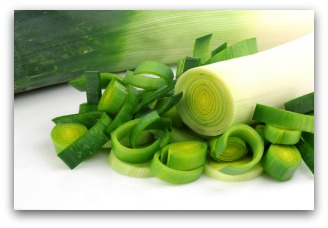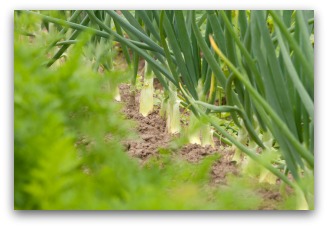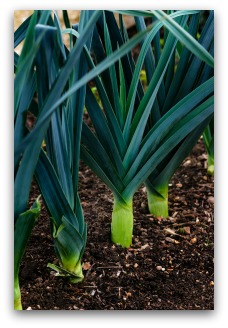All About Growing Leeks in Your Garden
Here are some easy tips for growing leeks in the garden!
Learn how to plant, grow and care for leek plants in your home vegetable garden.
Design Your Own Vegetable Garden Layout Using our Free "Vegetable Garden Planner" Software!
No matter what age you are, developing raw talents can lead to greater rewards in life and possibly supplemental income.
You may surprise yourself at your ability to pick up new gardening skills quite naturally, and growing leeks can be part of the adventure!
When people choose their garden design, they often do not consider nurturing vegetables that may be unfamiliar to them.
In times of economic struggles, growing your own produce is a valuable means of cutting the family food budget.
You may discover unique taste sensations along the way.
Growing Leeks in Home Vegetable Gardens
It does not take long to find the task at hand of how to grow leeks can be easily undertaken.
Leeks thrive in enriched, well worked beds, provided with steady moisture, and proper drainage.
Although, the plants are grown as annuals, leeks are a hardy biennial plant.
Leeks are related to the onion family.
They differ from their relatives by instead of having a bulb, and they have a stalk.
Instead of being hollow, the plant's flat leaves are strap-like.
Planting Leeks,
The leek plant produces a cool season crop.
The plants will endure warmer temperatures.
However, the crop will produce better results if grown under cooler conditions.
Growing temperatures less than 75 degrees F. will result in a bountiful harvest.
Download Free Garden Planning Worksheets, Garden Diary, Zone Chart, Or Planting Guide
In the spring, plant seed a month to a month and a half prior to the expected last frost.
Transplants may be planted in the fall to produce a late harvest.
Planting transplants during the springtime in place of seeds speeds up the harvest and avoids hot summertime temperatures.
Growing Leeks
• Plant leek seeds 1/8 inch deep.
• Later, thin seedlings to 6-9 inches between plants.
• Make 6 inch deep holes for transplants, in wide or single rows.
• Growing leeks prefer a location that receives full sun.
Caring for Leek Plants in the Garden
As the plants grow, hill the soil around the stalk to blanch the lower half of the stem.
Gardeners use this technique to grow white, large leeks.
Around midsummer, removing the top section of leaves encourages the leaf stalk to grow larger.
Vegetable Gardening Tip for Harvesting Leeks
You can prolong your leek harvest by using the following method.
Dig your summer leeks carefully.
Take a good portion of the root ball. Trim about one inch above the roots.
Replant; leaving about half of the stem above ground.
Water well.
Within a week or so, most of the replanted roots will begin to develop new stems.
Using this tip can even work with store bought leeks as well as long as roots are still white and swollen.
The second harvests are typically not as large as the initial harvest but they still delightfully wake up a fall salad, or make a nice pot of fresh leek soup!
Many vegetable gardeners do not attempt to grow leeks because of the extra time it takes to hill the stems to blanch them.
Some people also frown on the trouble they face washing out the bits of soil that becomes trapped in the layers of leaves.
An alternative to this method is not to blanch.
If you decide that you do not want to blanch leeks anymore, the green part of the stem is just as tender as the white.
The only noticeable difference is the color.
You will know that you have chosen the right path pursuing vegetable gardening as a hobby when you happily lose track of time in the garden.
Avid gardeners are never satisfied with the status quo and will go to great lengths to grow the finest produce.
No matter which plants you wish to try your hand at, whether learning how to grow leeks or other more exotic species, you probably know nurturing people who can offer expert advice.
Ask at the local garden clubs for helpful information about native plants.
Leave no stone unturned in your pursuit for becoming a successful gardener!
You Might Also like to Read:







